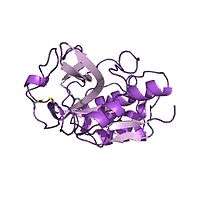Chymopapain
| Chymopapain | |||||||||
|---|---|---|---|---|---|---|---|---|---|
|
Chymopapain's structure | |||||||||
| Identifiers | |||||||||
| EC number | 3.4.22.6 | ||||||||
| CAS number | 2593837 | ||||||||
| Databases | |||||||||
| IntEnz | IntEnz view | ||||||||
| BRENDA | BRENDA entry | ||||||||
| ExPASy | NiceZyme view | ||||||||
| KEGG | KEGG entry | ||||||||
| MetaCyc | metabolic pathway | ||||||||
| PRIAM | profile | ||||||||
| PDB structures | RCSB PDB PDBe PDBsum | ||||||||
| |||||||||
| Clinical data | |
|---|---|
| Routes of administration | Injection into intervertebral disc |
| ATC code | M09AB01 (WHO) |
| Legal status | |
| Legal status |
|
| Identifiers | |
| ChemSpider | none |
| UNII |
1UK146T40N |
| ChEMBL |
CHEMBL1201626 |
| | |
Chymopapain (EC 3.4.22.6, chymopapain A, chymopapain B, chymopapain S, brand name Chymodiactin) is a proteolytic enzyme isolated from the latex of papaya (Carica papaya). It is a medication used to treat herniated lower lumbar discs in the spine.[1] Chymopapain injections are normally given under local, rather than general, anaesthesia. The dose for a single intervertebral disc is 2 to 4 nanokatals, with a maximum dose per patient of 8 nanokatals. The procedure is referred to as chemonucleolysis.
The sale and distribution of chymopapain was discontinued in the United States on January 27, 2003 after the company producing it decided to stop selling worldwide.[2][3]
Side effects
Serious side effects from the use of chymopapain include anaphylaxis, paralysis of the legs, or death.[4]
See also
References
- ↑ Chymopapain Injection from MedicineNet
- ↑ http://www.mayoclinic.com/health/drug-information/DR600373
- ↑ The Current Status of Chymopapain
- ↑ http://www.mayoclinic.com/health/drug-information/DR600373
External links
- The MEROPS online database for peptidases and their inhibitors: C01.002
- Data sheet for Papain from BIOZYM
